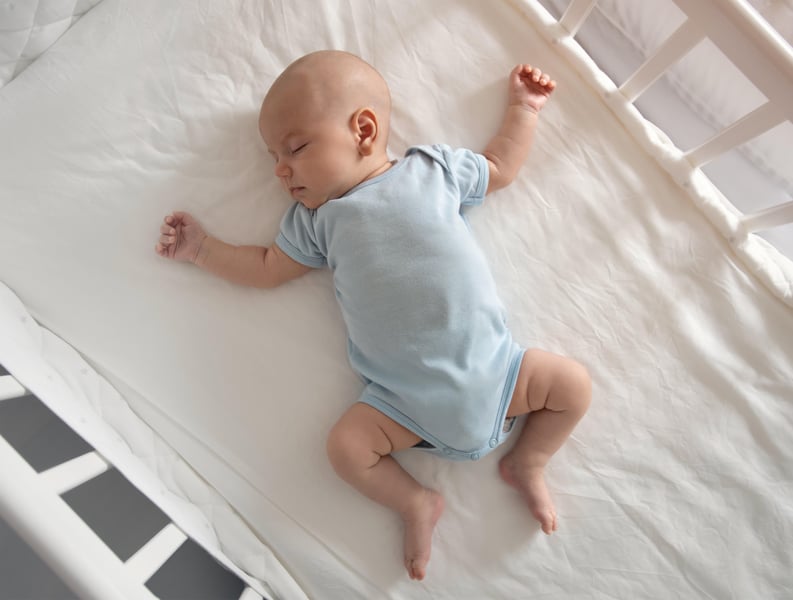Get Healthy!

- Alan Mozes
- Posted January 26, 2023
Siblings of Babies Who Died of SIDS May Also Face Higher Risk
Researchers have long struggled to figure out what causes a seemingly healthy baby to die suddenly in the first year of life, with an array of possible genetic and environmental factors to choose from.
Now a large, Danish study has found that in families where one child has succumbed to sudden infant death syndrome (SIDS), a younger sibling's risk appears to quadruple.
"I am not very surprised by these findings,"said Dr. Michael Goodstein, a member of the American Academy of Pediatrics Task Force on SIDS, who reviewed the study.
Goodstein, division chief of newborn medicine with WellSpan Health in York, Pa., noted that "other studies, including ones in the U.S. and the U.K., have shown a small but real increase in the risk of SIDS for subsequent siblings."
He said the current study "is consistent with previous findings that found a five to six times increased risk of SIDS."
Another U.S. expert agreed.
"We've known for a long time that there is heritable risk in SIDS,"said Dr. Richard Goldstein, director of the Robert's Program on Sudden Unexpected Death in Pediatrics at Boston Children's Hospital-Harvard Medical School, in Boston.
Goldstein, a co-author of the American Academy of Pediatrics' policy on safe infant sleep, pointed to a 2017 study in Utah that found a 400% higher risk of SIDS among siblings.
The new research was led by Dr. Charlotte Glinge, a physician at the Heart Center at Copenhagen University Hospital. It tracked SIDS among more than 2.6 million babies born in Denmark between 1978 and 2016.
During that time, 1,540 babies died of SIDS, leaving behind roughly 2,400 younger siblings.
After tracking outcomes during the younger siblings' first year of life, researchers found that their risk for SIDS appeared to be about four times higher than the general population.
"The popular view is that SIDS involves normal children who end up in dangerous sleep positions or environments, and then suffocate," Goldstein said. "While suffocation does occur, that is not what we study as SIDS. We work under the hypothesis that these deaths occur in infants with inapparent vulnerabilities who die when confronted with modest threats -- threats a normal baby would survive."
That's not to say there is only one cause for SIDS, he stressed.
Genetics may play a role, Goldstein said, with a heightened risk for heart trouble and epilepsy among possible contributors. Environmental exposures, including parents' smoking histories, may also have a role.
And, Goodstein noted, the potential impact of environment was not accounted for in the Danish study, so "it's impossible to sort out the environment from the genetics."
In the end, "both environment and genetics likely play a role," Goodstein added. "But it can be hard to tease out how much of a role each plays in any individual case."
And both experts urged families to avoid being overly alarmist, even though, as Goldstein acknowledged, "it is pretty hard to frighten parents who have lost their baby to SIDS; they have experienced a pain that most of us can't even begin to imagine."
Goodstein pointed out that even if sibling risk is notably higher, overall, "the risk for subsequent siblings remains low,"amounting to less than 1%.
"It is critical that we continue to educate all parents and caregivers on a safe sleep environment to minimize the risk of SIDS and prevent accidental suffocation and strangulation," Goodstein said. "We invite all clinicians to foster a dialogue grounded in respect, understanding of the family's goals, their protective and risk factors, and planning ahead to reduce the risk of sleep-related deaths, thereby promoting and practicing the most up-to-date guidelines on safe infant sleep."
The U.S. Centers for Disease Control and Prevention says babies should always be placed on their back to sleep. Soft bedding -- such as blankets, pillows, bumper pads and soft toys -- should be kept out of baby's sleep area, and sharing a bed with babies is not advised.
There are about 3,500 sleep-related deaths a year among U.S. babies, the CDC said.
The findings were published online Jan. 25 in JAMA Network Open.
More information
There's more on SIDS at the U.S. Department of Health and Human Services.
SOURCES: Michael Goodstein, MD, division chief, newborn medicine, WellSpan Health, York, Pa., member, American Academy of Pediatrics Task Force on SIDS, and co-author of AAP policy on safe infant sleep; Richard Goldstein, MD, director, Robert's Program on Sudden Unexpected Death in Pediatrics, Boston Children's Hospital-Harvard Medical School, Boston; JAMA Network Open, Jan. 25, 2023, online







